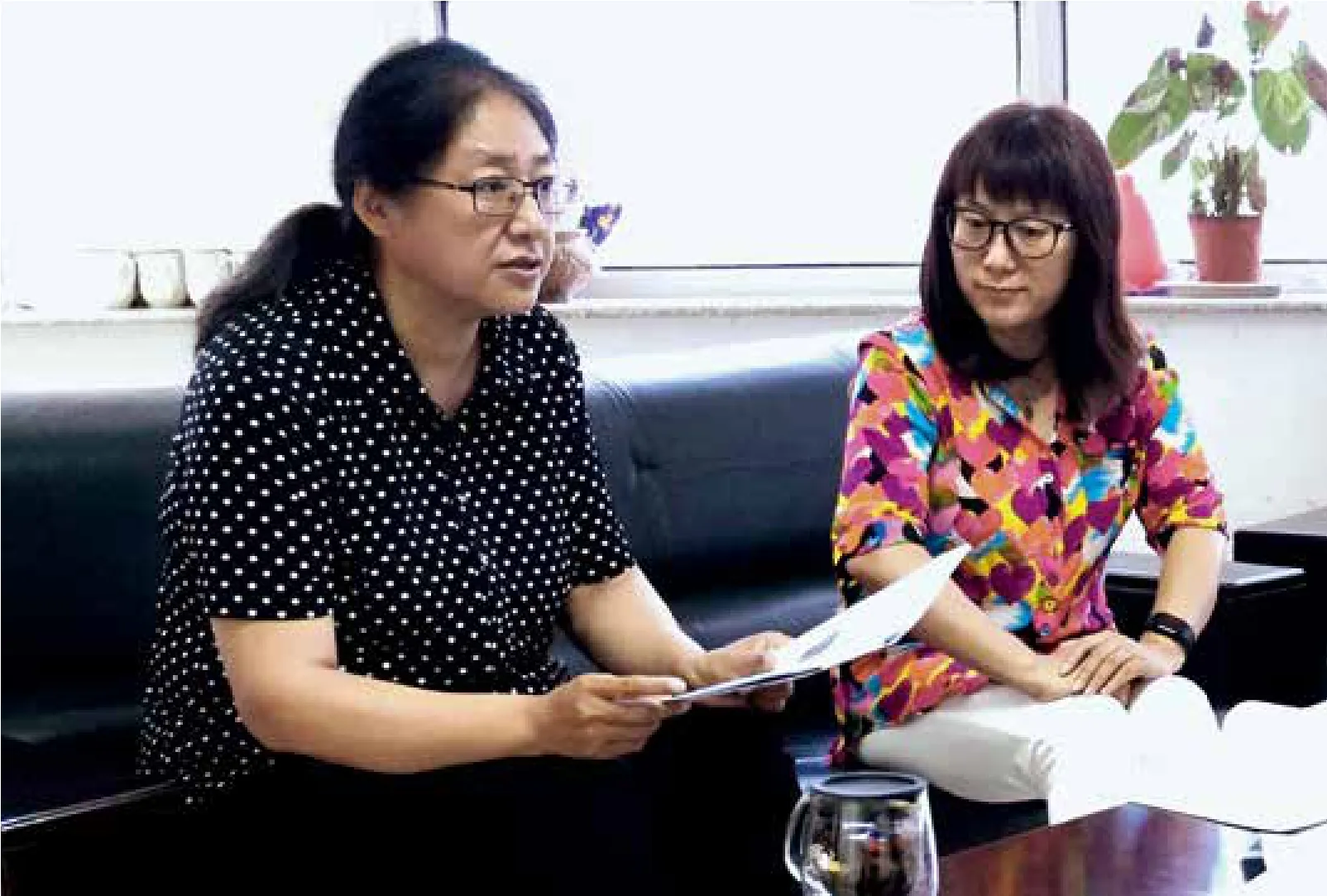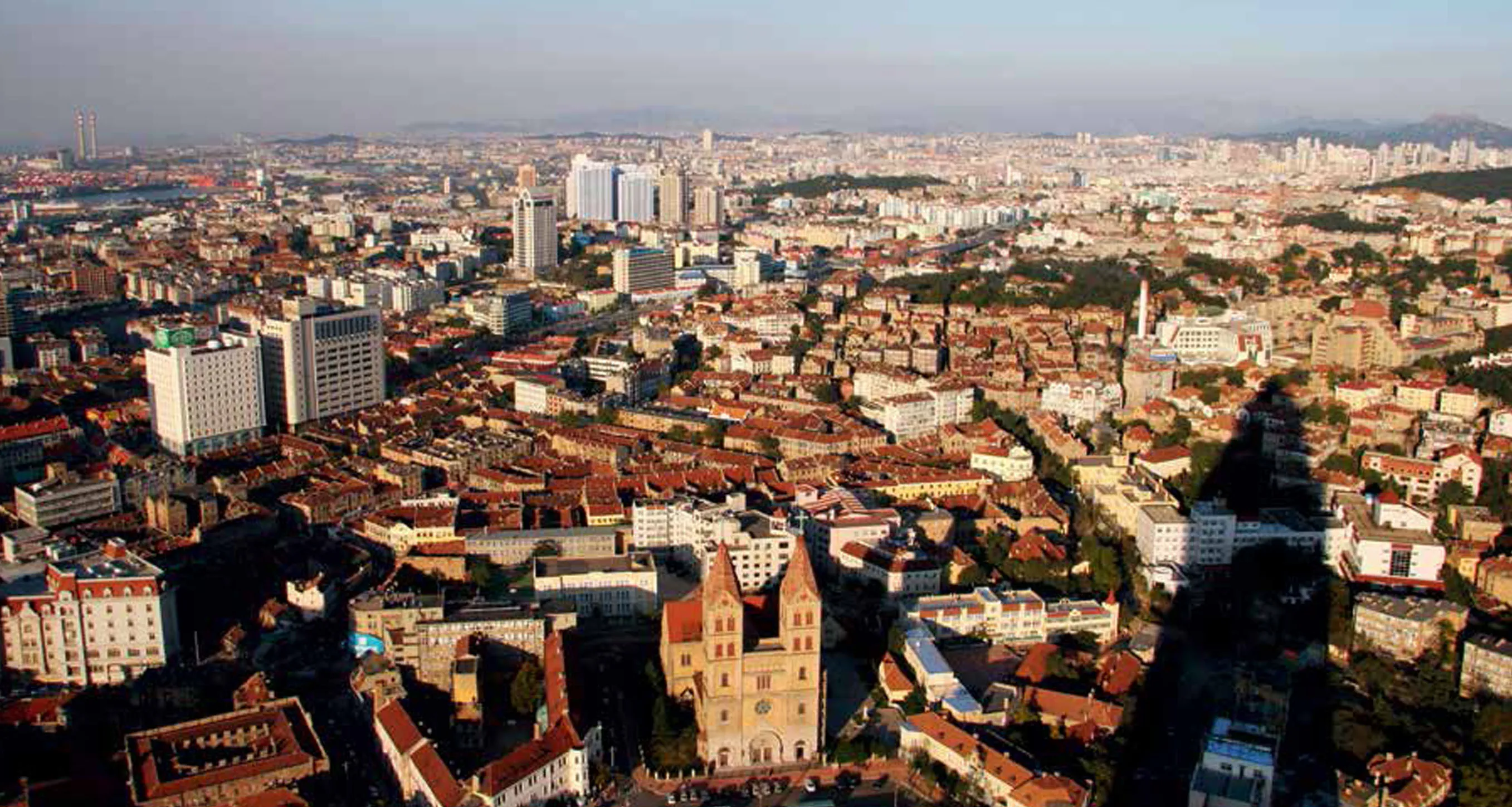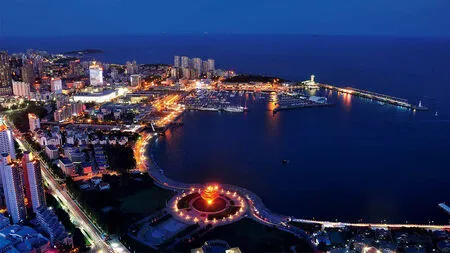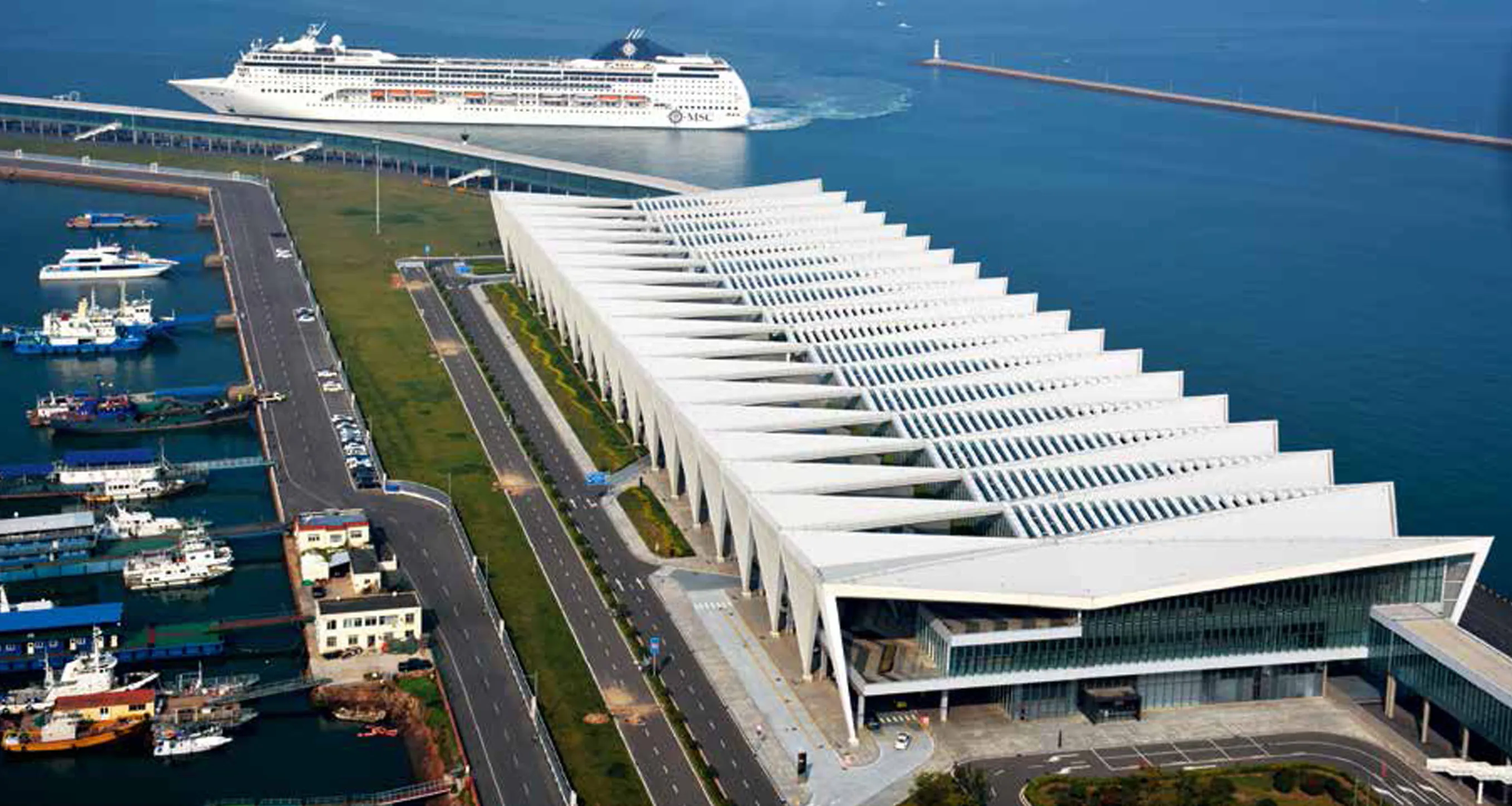滕军红·说青岛
2018-03-11腾军红,刘志强,李思予
Q1 针对青岛老城区,请您谈谈文化传承与城市发展的关系。
青岛这座城市在中国近代史中占据重要地位,大量完整的历史街区、历史建筑等文化遗产为青岛赢得了广泛的美誉度和知名度,同时这些文化遗产在现代化城市中仍然扮演着重要的角色,这些集体记忆的传承是青岛城市未来发展不可替代的资本。青岛城市的高水平发展,也为这些文化遗产的保护利用、持续“发光”赢得社会认同,奠定经济基础。在平衡两者关系上,我们近些年做了一些探索和努力。
例如,在宏观层面,制订有利于老城区保护的城市空间发展战略,更新和拓展是城市发展不可遏制的力量,在近三十年快速发展的时期,我们制定出“跳出老城、发展新城”的城市空间战略。在90年代初将行政中心东迁,为青岛老城区有效缓解了空间不足的压力,“从城市空间发展战略角度保护老城区”方面甚至是可以写入教科书的经典案例。后来“西跨”开发黄岛、到“三城”推进西海岸新区、北岸城区的建设,都是这一理念的延续。
微观层面,鼓励和调动社会各界力量,合理、永续利用各类老建筑,将部分老建筑和工业遗产活化为文化博览设施和文化创意空间,例如啤酒博物馆、邮电博物馆、中联U谷产业园等,均取得了良好的社会和经济效益。近些年,民间资本自发改造和利用老建筑也逐步成为一股新的力量,例如汇聚于大学路周边的咖啡一条街,人气和口碑极高。
文化传承反映了历史积淀,也映射出城市对未来发展的憧憬,我们需要构建属于未来城市的集体记忆,增强市民的归属感,让青岛不仅在经济、社会发展方面得到广泛认可,更在文化传承方面获得广泛的认同和尊重。
Q2 青岛有不少具有特色的街区,请谈谈您认为其中最具代表性的街区,它们对于青岛有何影响?
青岛共有13片历史文化街区,有以文旅、商服功能为主的,例如中山路、馆陶路、观海山、四方路(图2)和奥帆中心历史文化街区;有以旅游、疗养功能为主的,例如八大关、鱼山和八关山历史文化街区;有以居住功能为主的,例如信号山、观象山、武定路、黄台路和无棣路历史文化街区。这些街区在空间上是相连的,在功能上是互补的,特色和价值不尽相同,其中最具代表性的街区有两个,一是八大关历史文化街区,二是中山路历史文化街区。
八大关历史文化街区(图3)占地179公顷,现有建筑1,050栋,其中文物保护建筑236栋,2005年被《中国国家地理》杂志评选为中国最美的五大城区之一,2009年入选首届中国历史文化十大名街之一。街区内主要道路以关隘命名,不同街道设置不同的绿化树种,形成“一关一树,关关不同”的景观特色。在树种的配植上经过精心规划,形成八大关三季有花,四季常青,主色调随季节不断变化,移步异景的独特美景。街区内历史建筑集合了俄、英、法、德等24个国家的多种郊野别墅风格和大量早期现代派风格建筑,有“万国建筑博览会”之称。
中山路历史文化街区是青岛在现代城市规划思想指导下最早进行开发建设的区域之一,是青岛城市规划与建设的“起点”,也是青岛唯一一条具有百年历史的商业街。街区建设密切结合自然本底,保存了完整的空间形态和格局。街区内保留了天主教堂、洋行、戏院、饭店等数量众多的历史公共建筑,风格多元、设计考究、建造精美。同时,汇集了仍与现代城市生活息息相关的老字号商铺,是城市的精华与名片,也是市民的情感寄托。目前,中山路的发展整合了青岛湾滨海旅游资源、腹地里院传统文化资源,延续传统商业中心地位,引入高端特色酒店、精品商业,形成了多元化的旅游休闲区。

图1 / Figure 1 2018年8月3日,滕军红在青岛规划局接受采访,韩青博士协助访谈Ms.TENG Junhong in interview with Dr. HAN Qin, August 03,2018, Qingdao Urban Planning Bureau, Qingdao,China)来源 / Source: 刘志强 摄 / Photo by LIU Zhiqiang
Q3 您认为西海岸新区的建设对于青岛的整体城市空间发展有何影响?
青岛自1891年建置100多年来,城市空间经历了多次发展变迁,形成了现在的“三城”格局。
(1)20世纪90年代以前,青岛在最初殖民时期以栈桥、中山路为核心的区域,逐步沿胶州湾东岸向北,呈组团式拓展到四方、沧口一带,据1957年统计,城市建成区面积为35.6km2。城市从最初的港口商贸功能,逐步依托胶济线发展纺织等轻工业以及钢铁、化工、机车等重工业;90年代,青岛市政府提出行政中心东迁,东部成为青岛市新的政治、经济、文化中心,青岛东岸城区(图4)的城市框架逐步拉开。
(2)进入21世纪,青岛市在“十五”规划中做出经济重心西移的战略决定。为响应这一决定,青岛港于2002年将外贸集装箱航线整体西迁至前湾港。青岛市以港口西迁、城市西跨为契机,形成了青岛为主城、黄岛为辅城、环胶州湾发展的“两点一环”的空间格局,也奠定了青岛西岸城区的雏形。
(3)2008年青岛市政府在胶州湾底打造国家级高新技术开发区,2012年成立红岛经济区,依托大沽河生态中轴,打造“科技、人文、生态新城”。青岛逐步实施“三城联动”城市空间发展战略,环胶州湾城市框架形成。其中东岸老城区重在做优做美,北岸城区重在做高做新,西岸城区重在做大做强。
2014年6月,国务院发布《国务院关于同意设立青岛西海岸新区的批复》,青岛西海岸新区包括青岛市黄岛区全部行政区域,其中陆域面积约2,096km2、海域面积约5,000km2。该区域的总体规划即将批复,新区以海洋经济发展为主题,并服务于青岛主城,建设区域性经济中心和国际化城市。从规模上看,西海岸新区涵盖了青岛市近20%的陆域面积和40%的海域面积,其发展建设一方面为实施国家海洋强国战略提供了空间载体,另一方面也是青岛市由“环胶州湾三城格局”向“湾区城市群”空间跨进的必然选择。另外,对于港口运输和重工业转移、优化城市功能结构,打造青岛新的标志性滨海区域,体现青岛气派等也具有重要意义。

图2 / Figure 2四方路里院建筑群Sifang Road Liyuan Complex来源 / Source: 青岛市规划局 提供 / Provided by Qingdao Urban Planning Bureau
Q4 青岛拥有多项宜居城市的称号,您认为青岛的宜居性体现在哪几个方面?
1996年联合国第二次人居大会提出了“城市应当是适宜居住的人类居住地”,得到了国际社会的广泛共识,成为21世纪新的城市观。青岛市多次出现在国内外相关研究机构发布的“宜居城市”排行榜上。其中,中国城市竞争力研究会发布的《中国十佳宜居城市》,青岛在综合宜居性评价中荣登榜首。综合比较,青岛的宜居性主要体现在以下几个方面。
(1)社会和谐稳定。根据中国城市竞争力研究会发布2017中国最安全城市排行榜,青岛紧随香港之后位列第二位,成为了内地安全排名第一的城市。青岛市在社会治安、事故防范、生态控制等方面均形成了相对完善的安全防控体系。
(2)气候环境宜人。由于城市南向面海,海洋环境直接调节导致了温带海洋性季风气候特点,空气湿润,雨量充沛,温度适中,四季分明,空气质量极佳,是避暑和疗养胜地。
(3)城市风景优美。青岛是一座具有“红瓦绿树碧海蓝天、山海相依城景共融”特质的“景中都会”,尤其是滨海区域具有有极高的美誉度,也是中国唯一入选“世界最美海湾”的城市。
(4)历史人文资源丰富。青岛的历史城区,其整体规模、建设水平、保护完整程度,在国内是极少见的。既有像八大关这样展示多元外来文化的“万国建筑博览会”,又有里院这样体现青岛特色的平民生活样本。20世纪30年代山东大学迁至青岛,老舍、洪琛等众多文化名人陆续定居,更是为这座历史名城留下了浓厚的人文色彩。
(5)生活服务方便。近年来,青岛以打造幸福宜居的现代化国际城市为目标,全市统筹,新建了包括市民健身中心、市民健康中心、青岛中学、文化艺术中心等一批市级公共服务设施,进一步提升城市综合服务能级;另外,以社区服务中心为基础,完善基层公共服务设施,为全市各个层面提供优质方便、公平均等的生活服务。
(6)出行便捷。对外出行方面,可以选择航空、高铁、高速公路等多元化出行方式,邮轮母港的建设更是具有青岛特色出行体验方式;市内出行方面,青岛是山东省最早进入“地铁时代”的城市。目前,已开通运营3条线路,约108km,还有6条线路在建。按照《青岛市城市轨道交通线网规划》,未来线网达到18条、站点400余个,全长838km,中心城区800m半径站点覆盖率将达到80%,在全国处于领先地位。
Q5 您认为青岛居民有哪些生活情趣?这对塑造城市空间特质有何积极影响?
从历史上看,近代被殖民时期,青岛传入了多元的外来文化,尤其是德国殖民者对生活品质和环境的追求,使青岛这座城市深深打上了“小资”“时尚”的生活情趣烙印,并一直流传下来。从地理上看,青岛又是一个以渔为生,因港而兴的滨海城市,自古以来与海洋的互动造就了青岛人天生“热情、豪爽”的性格特征。
青岛居民既“小资时尚”又“热情豪爽”的生活情趣体现了国际化与本土化的融合,是不同文化的叠加。这些文化特征由青岛特有的物质空间所承载:从八大关、鱼山独栋庭院别墅里的文化创意工坊和咖啡馆、四方路里院改造的客栈和小吃店,到滨海一线的风景和美轮美奂的夜景亮化,等等,都展现了青岛城市的小资与时尚;大大小小的海水浴场为市民亲近海洋提供场所,琳琅的啤酒街、美食街热闹非凡,滨海大尺度的沙滩广场为举行啤酒节、音乐节等全民节庆活动、市民欢聚畅饮提供场所。
历史建筑、工业遗产、沙滩广场、滨海新区这些青岛特有的物质空间载体因为与青岛居民的生活息息相关而富有活力,历史元素不再仅停留在封存、保护上,而是与现代需求结合,活化利用、重现光彩;时尚美丽的滨海地区也作为城市名片,让市民获得了归属感和自豪感。

图3 / Figure 3八大关历史文化街区Badaguan (Eight Great Passes) Historical and Culturual Area来源 / Source: 青岛市规划局 提供 / Provided by Qingdao Urban Planning Bureau
Q6 作为一座旅游城市,您认为游客对青岛城市空间有何影响?
青岛作为一座国际性旅游城市,最主要的旅游资源体现在2个方面:自然山海禀赋和气候环境优势;格局完整、风貌统一的历史城区,大量保存良好的近现代历史优秀建筑和工业遗存,为度假康养、重大赛事和活动举办所提供的现代化、高品质物质空间条件。青岛市旅游业持续快速发展,根据统计,2017年全市接待游客总人数超过8,800万人次,同比增长9%;实现旅游消费总额1,653亿元,同比增长15%,游客也逐渐从观光游向休闲度假游转变,对城市空间产生了很多积极影响。
第一,促使滨海公共空间(图4)由“线”向“带”的转变,功能由单一的景观观赏、亲海游乐向综合性、体验性公共服务转变。目前,青岛围绕滨海岸线、沙滩等游资源逐步聚集了大量度假酒店、商业综合体、游乐游憩综合体以及高端办公等设施,改变了以往滨海区域只有一条“线”的情况,大大增加了滨海公共性区域的“厚度”和复合功能,使得滨海区域更加具有活力。
第二,促进了老城区(图5)的保护与更新。在刚刚召开的上合组织青岛峰会上,青岛向世界展示了深厚的文化底蕴和独特魅力,极大提升了城市的知名度和美誉度。其中,最具魅力和底蕴的历史城区是游客必游必逛的地方,通过利用历史建筑、工业遗产,注入符合空间使用要求的文化、商业、创意产业等业态,既满足了游客的深度体验需求,又积极保护利用了历史资源,逐步焕发老城区活力。国棉六厂创意产业园、啤酒博物馆、1907光影俱乐部、中山路壹号等都是实现多方共赢的例子。
第三,为游客提供全天候、全方位、一站式服务的综合文旅项目,加快推动了区域的发展。例如,结合大港老港区整体转型升级,建设综合文旅项目,将以此契机全面带动老城区更新与复兴;西海岸的万达影视主题文旅项目也快速拉动了周边区域的居住、商服功能的发展。

图4 / Figure 4俯瞰浮山湾Overlooking Fushan Bay来源 / Source: 青岛市规划局 提供 / Provided by Qingdao Urban Planning Bureau

图5 / Figure 5青岛湾老城区鸟瞰图Overlooking Fushan Bay来源 / Source: 青岛市规划局 提供 / Provided by Qingdao Urban Planning Bureau
Q7 请您列举一例青岛最具特色的场所,并说明理由。
青岛有很多代表性的特色场所,例如栈桥、八大关、汇泉湾海水浴场、五四广场等,它们建于不同时代,是各自时期青岛城市发展的典型代表,若综合考虑地理环境、文化价值、国际知名度、时代意义等因素,推荐青岛奥林匹克帆船中心。
青岛奥帆中心所在区域前身为北海船厂,是现代中国最大的船舶制造企业之一。为迎接奥运会帆船比赛,2003年,青岛市政府把北海船厂搬迁到黄岛;2006年奥帆中心建成;2008年,作为第29届奥运会和第13届残奥会帆船比赛的场地。奥帆中心是珍贵的奥运文化遗产,也展现了青岛作为世界“帆船之都”的魅力形象。2011年,青岛奥林匹克帆船中心列为第九批青岛市文物保护单位,是青岛市唯一建于当代的历史文化街区(共13片),是全市人民的一笔宝贵财富。
2010年,百丽广场、心海广场、青岛奥帆博物馆、青岛奥帆大剧场等设施场所先后建成。原运动员中心升级为超五星级酒店—青岛海尔洲际酒店,原媒体中心也变身为专为高端客户服务的青岛国际游艇俱乐部。奥运结束后,青岛奥林匹克帆船中心完成了从单纯的帆船比赛场地,到集赛事旅游、餐饮娱乐于一体的“复合型城市场所”的华丽转身。
2018年6月9日,上海合作组织峰会在青岛举行。作为峰会主会场的奥帆中心又一次成为世界瞩目的焦点。借峰会契机,进一步提升功能,融合休闲度假、会议会展、帆船赛事、酒店娱乐、演艺节庆、宴会典礼、文创产品等相关产业,打造多元化的滨海旅游新地标。
经历北海船厂的过往、奥运会的洗礼、上合峰会的升华,奥帆中心见证了当代青岛城市大事件,是新世纪弘扬青岛精神、彰显城市品质的最具有特色的场所。透过它,世界将认识青岛,并更加了解青岛。
FULL TEXTS TRANSLATED FROM CHINESE
[U-TALK]
TENG Junhong·TALK about Qingdao City
[Interviewee]TENG Junhong
[Date]August 3, 2018
[Place]Qingdao, China
[Interviewer]LIU Zhiqiang
[Translator]LI Siyu (from Chinese to English)
TENG Junhong is currently the vice director of Qingdao Urban Planning Bureau. She is PhD majoring urban plan graduated from Tianjin University(Figure 1).
Source: Provided by Ms.TENG Junhong
1 Regarding to the old urban district of Qingdao, can you talk about the relationship between cultural heritage and urban development?
The city of Qingdao occupies an important position in China's modern history. A large number of cultural heritages such as complete historical neighborhoods and historical buildings have won extensive reputation and popularity for Qingdao, and meanwhile they still play an important role in the modern city. The inheritance of these collective memories is irreplaceable capital for the future development of Qingdao. The high-level development of the city of Qingdao will also win social recognition and lay the economic foundation for the protection and utilization as well as the continuous “glowing”of these cultural heritages. In balancing the relationship between the two, we have made some exploration and efforts in recent years.
For example, at the macro level, urban spatial development strategies that are conducive to the protection of the old urban district have been developed. Renewal and expansion are unstoppable forces for urban development. In the period of rapid development in the past 30 years, according to the urban space strategy of “jumping out of the old urban district and developing new urban districts” we formulated,in the early 1990s, the administrative center was moved eastward, which effectively alleviated the pressure of insufficient space for the old urban district of Qingdao. The aspect of“protection of the old urban district from the strategic perspective of urban space development” is even a classic case that can be written into textbooks. Later, the “west stepping” for development of Huangdao and the “three urban districts” for promoting the construction of the west coast new district and the north coast urban district are all continuations of this concept.
At the micro level, we have encouraged and mobilized all sectors of society to make rational and sustainable use of all types of old buildings.Some old buildings and industrial heritages have been revitalized into cultural expo facilities and cultural creativity spaces, such as the Beer Museum, the Post and Telecommunications Museum, and the Zhonglian U Valley Industrial Park, which have all achieved good social and economic benefits. In recent years, the spontaneous transformation and use of old capital by private capital has gradually become a new force. For example, the street with coffee shops that gather at sides of Daxue Road has a skyhigh popularity and reputation.
Cultural heritage reflects the historical accumulation and also the city's visions for future development. We need to build a collective memory belonging to the future city, enhance the sense of belonging of the citizens, and let Qingdao not only be widely recognized in terms of economic and social development, but more importantly, also gain wide recognition and respect in terms of cultural inheritance.
2 Qingdao has many distinctive neighborhoods. Please talk about the ones among them which you think are the most representative. What is their impact on Qingdao?
There are 13 historical conservation neighborhoods in Qingdao, some are mainly based on the functions of cultural tourism and business services, such as Zhongshan Road, Guantao Road, Guanhai Mountain, Sifang Road and the Olympic Sailing Center historic conservation neighborhoods; some are mainly based on the functions of tourism and recuperation,such as the Eight Great Passes, Fish Mountain and Baguan Mountain historical conservation neighborhoods; some are mainly based on residential functions, such as the Signal Hill,Guanxiang Mountain, Wuding Road, Huangtai Road and Wudi Road historical conservation neighborhoods. These neighborhoods are spatially connected, functionally complementary,with different characteristics and values. Among them, there are two most representative neighborhoods, one is the Eight Great Passes historical conservation neighborhood, and the other is the Zhongshan Road historical conservation neighborhood.
The Eight Great Passes historical conservation neighborhood covers an area of 179 hectares,with 1,050 existing buildings which include 236 heritage conservation buildings. In 2005, it was selected as one of the five most beautiful urban districts in China by China National Geographic magazine. In 2009, it was selected as the first Top Ten Chinese Historical Conservation Famous Neighborhood. The main roads in the neighborhood are named after passes, and different greening trees species are set up in different streets to form the landscape feature of “one tree species for one pass, different views for different passes”. After careful planning of the planting of tree species, the unique beauty of the Eight Great Passes has been formed where flowers can be seen in three seasons and evergreens in four seasons, the main hues change with the seasons, and varying sceneries can be seen with changing view-points. The historical buildings in the neighborhood are a collection of buildings with various countryside villa styles of 24 countries including Russia, Britain, France and Germany and a large number of early modernist style buildings. They are known as the “Exhibition of the World's Architecture”.
Zhongshan Road historical conservation neighborhood is one of the earliest areas for the development and construction of Qingdao under the guidance of modern urban planning ideas.It is the “starting point” for Qingdao urban planning and construction, and the only commercial street in Qingdao with a history of 100 years. The neighborhood was constructed in close combination with the natural background,therefore the complete spatial form and pattern is preserved. The neighborhood retains a large number of historical public buildings such as Catholic churches, foreign shops, theaters,restaurants, etc. which feature diverse styles,sophisticated design and exquisite construction. At the same time, it brings together the time-honored shops that are still closely related to modern urban life. They are the essence and name card of the city, and also emotional sustenance for the citizens. At present, the development of Zhongshan Road integrates Qingdao Bay coastal tourism resources, traditional cultural resources of Liyuan in the hinterland, and continues the status of traditional commercial centers, introducing high-end specialty hotels and boutique businesses, forming a diversified tourism and leisure area.

图6 / Figure 6上合峰会 主会场Main conference venue of the SCO Summit来源 / Source: 青岛市规划局 提供 / Provided by Qingdao Urban Planning Bureau
3 What impacts do you think the construction of the west coast new district have on the overall urban space development in Qingdao?
Since its establishment in 1891, the city space in Qingdao has experienced many developments and changes, forming the current “three urban districts” pattern:
(1) Before the 1990s, in the initial colonial period, the area in Qingdao with the Zhanqiao Landing Stage and Zhongshan Road as the core gradually moved north along the east coast of Jiaozhou Bay, and expanded into the Sifang and Cangkou areas through the cluster pattern.According to the statistics of 1957, the urban built-up area is 35.6km2. From the initial port business function, the city gradually relied on the Qingdao-Jinan line to develop textiles and other light industries, as well as heavy industries such as steel, chemicals and locomotives; in the 1990s, the Qingdao Municipal Government proposed that the administrative center be moved eastward, the eastern part then became the new political, economic, and cultural center of Qingdao, and the urban framework of Qingdao's east coast urban district has gradually expanded.
(2) In the new century, Qingdao made a strategic decision on the westward shift of its economic center in the “10th Five-Year Plan”. In response to this decision, Qingdao Port moved the entire foreign trade container route to Qianwan Port in 2002. Taking the west move of the port and the west stepping of the city as an opportunity,Qingdao city formed the spatial pattern of “two points and one ring” where Qingdao is the main urban district, Huangdao is the auxiliary urban district and the city is developed around Jiaozhou Bay, which also laid the prototype of the west coast urban district of Qingdao.
(3) In 2008, the Qingdao Municipal Government built a national high-tech development zone at the bottom of Jiaozhou Bay. In 2012, the Red Island Economic Zone was established, relying on the central axis of daxie river ecology to create “new urban districts of science and technology, hunanity and ecology”. Qingdao gradually implemented the “three-district linkage” urban space development strategy, forming an urban district framework around Jiaozhou Bay. Among them, the focus on the east coast old urban district is to make it better and beautiful, and the north coast urban district higher and newer, the west coast urban district bigger and stronger.
In June 2014, the State Council issued Reply of the State Council on the Approval of the Establishment of the West Coast New District of Qingdao. The west coast new district of Qingdao includes all administrative areas of Huangdao District of Qingdao, of which the land area is about 2,096 km² and the sea area is about 5,000 km². The overall planning of the region will soon be approved. The new district will focus on the development of marine economy and serve the main urban district of Qingdao to build a regional economic center and an international city. In terms of scale, the west coast new district covers nearly 20% of Qingdao's land area and 40% of its sea area. Its development and construction on the one hand provides a space carrier for the implementation of the national maritime power strategy, and on the other hand, is also the inevitable choice for Qingdao city to step from the “pattern of three districts around Jiaozhou Bay” to the space of the “bay area city group”. In addition, it is also of great significance for port transportation and heavy industry transfer, optimization of urban functional structure, construction of Qingdao's new landmark coastal area, and reflection of the style of Qingdao.

图7 / Figure 7邮轮母港Cruise Home Port来源 / Source: 青岛市规划局 提供 / Provided by Qingdao Urban Planning Bureau
4 Qingdao has multiple titles as a liv-able city. What aspects do you think Qingdao's livability is reflected in?
In 1996, the second United Nations conference for human settlements proposed that “the city should be a livable place for human habitation”which gained broad consensus from the international community and has become a new urban view in the 21st century. Qingdao has appeared on the lists of “livable cities” published by relevant research institutions at home and abroad for many times. Among them, in China's Top Ten Livable Cities released by China Institute of City Competitiveness, Qingdao ranked first in the comprehensive livability evaluation.Through comprehensive comparison, Qingdao's livability is mainly reflected in the following aspects:
(1) The society is harmonious and stable.According to the list of the safest cities in China in 2017 released by China Institute of City Competitiveness, Qingdao ranked second after Hong Kong, becoming the city ranked first in safety in the mainland. Qingdao has formed a relatively complete security prevention and control system in terms of social security, accident prevention, and ecological control, etc.
(2) The climate and environment are pleasant. Since the south of the city faces sea, the direct adjustment of the marine environment has resulted in the temperate oceanic monsoon climate characteristics, and there is humid air,abundant rainfall, moderate temperature, four distinct seasons, and excellent air quality. It is a summer resort and health resort.
(3) The city has beautiful scenery. Qingdao is a“metropolis in scenery” with the characteristics of “red tile and green trees, blue sea and blue sky, mountains and seas adjacent to each other and fusion of urban districts and scenery”. In particular, the coastal area has a sky-high reputation and is the only city in China that has been selected as one of “The World's Most Beautiful Bays”.
(4) It has rich historical and human resources.The overall size, construction level, and integrity level of preservation of Qingdao's historical urban districts are extremely rare in China.There are not only the "Exhibition of the World's Architecture" which displays diverse foreign cultures like the Eight Great Passes; but also the Liyuan house as a sample of civilian life that reflects the characteristics of Qingdao. In the 1930s, Shandong University moved to Qingdao,and many cultural celebrities such as Lao She and Hong Yu settled here successively, leaving a strong humanistic color for this historic famous city.
(5) It has convenient living services. In recent years, Qingdao has made overall plans for the whole city and set up a batch of municipal-level public service facilities including the citizen fitness center, the citizen health center, the Qingdao middle school, and the cultural and art center, etc. with the target of establishing a modern international city that is livable and makes people happy, to further enhance the city's comprehensive service level; in addition, based on the community service center, the basic public service facilities can be improved to provide convenient, fair and equal quality services for all levels of the city.
(6) Travel is convenient. In terms of external trips, a variety of modes of travel such as aviation, high-speed rail and expressway can be picked. The construction of the cruise home port is also a reflection of a Qingdao-style travel experience. In terms of travel in the city, Qingdao is the first city in Shandong Province to enter the “Metro Age”. At present, three lines with a total length of 108 km have gone into operation, and six lines are under construction.According to the Qingdao Urban Rail Transit Network Planning, in future there will be 18 lines in the network, and more than 400 stations,with a total length of 838 km. The coverage of stations within the 800 m radius from the central urban district will reach 80%, taking the leading position in the country.
5 What kind of lifestyle do you think Qingdao residents have? What positive impacts do they have on shaping urban space traits?
Historically, during the colonial period in modern times, a variety offoreign cultures were introduced to Qingdao, in particular, the pursuit of life quality and environment by German colonists has deeply branded the city of Qingdao with a lifestyle of “petty bourgeoisie”and “fashion”, which have been passed down.Geographically, Qingdao is a coastal city that makes a living from fishing and is prosperous for its port. The interaction with the ocean since ancient times has created the “enthusiastic and straightforward” personality of Qingdao people.The lifestyle of Qingdao residents which features both “petty bourgeoisie and fashion” and“enthusiasm and straightforwardness” reflects the integration of internationalization and localization, and is a superposition of different cultures. These cultural features are carried by Qingdao's unique material space: from the cultural creativity workshops and cafes in the detached courtyard villas in the Eight Great Passes and Fish Mountain, the inns and snack bars remodeled from Liyuan in Sifang Road, to the scenery along the coast and the beautiful and fantastic lamps and lightning at night, etc., all show the petty bourgeoisie and fashion of Qingdao city;large and small bathing beaches provide a place for citizens to get close to the sea. The dazzling beer streets and food streets are very lively.The large-scale beach square in the coastal area provides a venue for the national festivals such as beer festivals and music festivals, and for the public to gather and drink.
Qingdao's unique material space carriers such as the historical buildings, industrial heritage,beach plazas, Binhai New Area are vital because they are closely related to the lives of Qingdao residents. Historical elements no longer only remain at the level of storage and protection, but are combined with modern needs, activated and utilized to reproduce their brilliance; the beautiful and fashionable coastal area also serves as a city name card, which gives the citizens a sense of belonging and pride.
6 As a tourist city, what impacts do you think tourists have on Qingdao's urban space?
As an international tourist city, Qingdao's main tourism resources are reflected in three aspects:natural mountain and sea endowments and climate and environmental advantages; a historical city with a complete pattern and unified appearance, a large number of well-preserved excellent historical buildings and industrial remains of modern times; modern, high-quality material space conditions for holiday and recreation, major competitions and events. Qingdao's tourism industry continues to develop rapidly,according to statistics, the total number of tourists received in the city in 2017 exceeded 88 million, realizing a year-on-year increase of 9%;the total tourism consumption reached 165.3 billion yuan, realizing a year-on-year increase of 15%. Tourists also gradually changed from going on sightseeing tours to having leisure vacations, which also had a lot of positive impacts on urban space.
First of all, it promoted the transformation of the coastal public space from “line” to “band” and the function from the single landscape viewing and pro-sea amusement to a comprehensive and experiential public service. At present, Qingdao has gradually gathered a large number of resort hotels, commercial complexes, amusement complexes and even high-end office facilities around tourist resources such as the coastline and beaches. This has changed the situation of the coastal area in the past which only has one“line” and greatly increased the “thickness” and composite function of the coastal public area,making the coastal area more dynamic.
Second, it promoted the protection and renewal of the old urban district. At the just-concluded SCO summit in Qingdao, Qingdao showed the world its profound cultural heritage and unique charm, which greatly enhances the city's popularity and reputation. Among them, the historical urban districts which are the most attractive and rich in profundity are must-visit places for tourists. By using historical buildings and industrial heritage, and infusing the culture, business, creativity industries and other formats of commerce which meet the requirements of space use, it not only meets the needs of in-depth experience of tourists, but also actively protects and utilizes the historical resources and gradually radiates the vitality of the old urban districts. Guomian Sixth Factory Creativity Industry Park, Beer Museum, 1907 Light and Shadow Club, Zhongshan Road No. 1 are all examples of achieving multi-win.
Third, it provided visitors with the comprehensive cultural tourism project that features all-weather,all-round and one-stop services which has accelerated the development of the region. For example,in combination with the overall transformation and upgrading of the old port area of Dagang, a comprehensive cultural tourism project was constructed, this will be an opportunity to comprehensively drive the renewal and revival of the old urban district; the Wanda Media theme cultural tourism project on the west coast also quickly promoted the development of residential and commercial functions of the surrounding areas.
7 Please list one of the most distinctive places in Qingdao and explain the reasons.
There are many representative special places in Qingdao, such as the Zhanqiao Landing Stage,Eight Great Passes, Huiquan Bay Bathing Beach, and May Fourth Square. They are built in different eras and are typical representatives of Qingdao's urban development in their respective periods. If we consider factors such as the geographical environment, cultural values,international popularity and significance of the times, etc. comprehensively, the Olympic Sailing Center of Qingdao is recommended.
Qingdao Olympic Sailing Center, formerly known as Beihai Shipyard, is one of the largest shipbuilding companies in modern China.In order to welcome the Olympic sailing competition, in 2003, the Qingdao Municipal Government relocated the Beihai Shipyard to Huangdao; in 2006, the Olympic Sailing Center was completed; in 2008, it was the venue for the 29th Olympic Games and the 13th Paralympic Sailing Competition. The Olympic Sailing Center is a precious Olympic cultural heritage and also shows the charming image of Qingdao as the world's “Sailboat Capital”. In 2011, Qingdao Olympic Sailing Center was listed as one of the ninth batch of cultural relics protection units in Qingdao. It is the only historical conservation neighborhood in Qingdao established in contemporary times (among a total of 13 neighborhoods) and is a valuable asset of the people of the city.
In 2010, Baili Plaza, Xinhai Plaza, Qingdao Olympic Sailing Museum, Qingdao Olympic Sailing Grand Theater and other facilities were built successively. The original athlete center was upgraded to a super five-star hotel—Inter-Continental Qingdao. The original media center also turned into Qingdao International Yacht Club which is dedicated to high-end customers.After the Olympics, Qingdao Olympic Sailing Center completed a gorgeous turn from a simple sailing venue to a “composite urban place” that combines events and tourism, dining and entertainment.
On June 9, 2018, the Shanghai Cooperation Organization Summit was held in Qingdao. As the main venue of the summit, the Olympic Sailing Center has once again become the focus of the world. Taking advantage of the summit,its functions will be further enhanced and it will integrate the leisure and holiday, conference and exhibition, sailing events, hotel and entertainment, performance and festivals, banquets and ceremonies, cultural creativity products and other related industries to create a diversified new landmark of coastal tourism.
Having experienced the past of the Beihai Shipyard, the challenge of the Olympic Games, and the advancements achieved through the SCO Summit, the Olympic Sailing Center has witnessed the contemporary Qingdao city events,and is the most distinctive place to promote the spirit of Qingdao and highlight the city's quality in the new century. Let the world know more about Qingdao and learn more about Qingdao through it.
